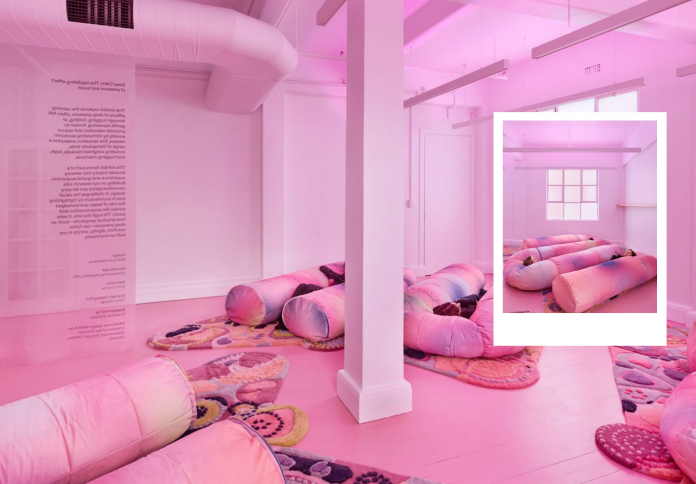Australian design studio Sibling Architecture invites visitors to experience a new dimension of architecture with their Deep Calm exhibition, running during Melbourne Design Week. Through custom tactile installations and immersive sensory elements, the exhibition explores how architecture can engage more than just our sight — evoking the calming sensation of a hug.

Rethinking architecture through the senses
Sibling Architecture’s Deep Calm exhibition, held from 15 to 25 May during Melbourne Design Week, offers a fresh take on how architecture interacts with the body and mind. The installation features a warm pink room filled with custom-designed rugs and weighted soft forms that encourage visitors to lie down, wrap themselves in soft pressure, and experience a sense of comfort and stillness.
Visitors are invited to physically engage with the space — whether by lying on the specially crafted rugs or wrapping the weighted soft forms around their bodies — immersing themselves in an environment designed to evoke calm through touch and proprioception, the sense of body awareness.
This exhibition is part of an ongoing research project by Sibling Architecture exploring sensory design, which seeks to expand architectural practice beyond visual aesthetics to incorporate how spaces can affect other senses and emotions.

Origins in neurodiverse design research
The inspiration behind Deep Calm stems from Sibling Architecture’s work on the Wangaratta District Specialist School in regional Victoria, a facility catering to students with neurodiversities and varying physical abilities. During this project, the studio focused on creating sensory spaces that engage multiple senses — including touch, sight, sound, and body awareness — to support learning and comfort.
“We found that the sensory spaces most loved by students were those that enabled them to interact in a way that encouraged a cause-and-effect understanding of their bodies in space,” explained the studio. For example, squeezing through a tight space would produce a physical feeling of release or comfort.
This led the team to investigate deep pressure therapy, a technique that applies gentle but firm pressure to the body to calm the nervous system. Often described as akin to a hug or gentle squeeze, deep pressure therapy promotes stillness, quietness of mind, and the release of mood-enhancing hormones like dopamine and serotonin.

Beyond the visual: A multi-sensory architecture
“Architecture often exists in mediums that primarily engage our visual receptors,” the studio noted. From sketches to photography, visual representation dominates the field, often overshadowing other sensory experiences.
However, awareness is growing around how people experience architecture in diverse, multi-sensory ways. Sibling Architecture emphasizes that sight alone accounts for only a small part of what shapes the atmosphere of a space, encouraging designers to consider the full range of sensory inputs in their work.

Immersive design details
The exhibition’s custom rugs were designed to match the natural posture of the human body when lying down. The pattern draws inspiration from acupressure mats, incorporating varying pile heights to heighten tactile sensations and enhance the calming effect.
Complementing the rugs are weighted soft forms crafted from custom-printed velvet — soft to the touch and filled with recycled foam and HDPE pellets, materials often used in stress balls. These forms feature adjustable “arms” that users can position around their body, simulating a heavy, comforting hug.
Adding to the sensory environment, the studio collaborated with Other Matter, a sustainable materials studio, to design scented glazing film that gently filters sunlight and softens the space’s light quality. Meanwhile, composer Jeanette Little created a calming soundscape intended to relax visitors and deepen their experience of stillness.
About sibling architecture
Founded in 2012, Sibling Architecture operates at the intersection of architecture, urbanism, and cultural analysis. Known for its innovative and research-driven approach, the studio previously designed a pop-up creative hub in a soon-to-be-demolished Melbourne building, further showcasing its commitment to community-focused and experimental projects.
With Deep Calm, Sibling Architecture invites the public to reconsider how architecture can feel — not just be seen — offering an intimate, sensory-rich experience that embodies the comforting embrace of a hug.










